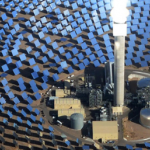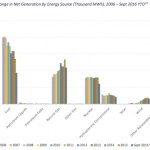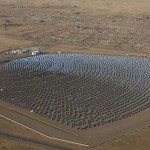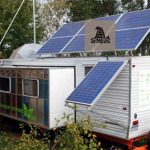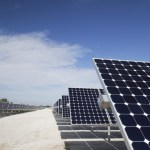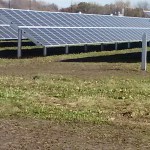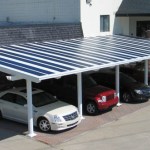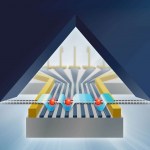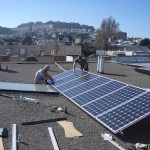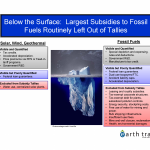solar energy
SolarReserve will build, for the South Australia government, a solar thermal plant rated at 150 MW, which is about 25 MW more than that government uses currently. Over time, assuming Australia goes all on clean and green, the amount of electricity used by South Australia will increase substantially, but for now, this plant will provide the extra to the regional grid.
A solar plant is a way of making the use of solar more full time. Instead of just producing electricity by sunlight, perhaps storing some in batteries, it uses sunlight to produce heat, which is then used to run a turbine all…
The solar energy field now produces the larest share of jobs in US Power generation. There are 374,000 jobs i Solar right now, compared to fewer than 190,00 in coal, gas, and oil.
This corresponds to shifts in the amount of electricity produced by these various sources, as indicated in the Department of Energy graph shown above.
The biggest states for this job growth are California followed distantly by Massachusetts, Nevada, New York, New Jersey, Texas, Arizona, Florida, and North Carolina.
Given current trends inside the beltway, I expect the Department of Energy to make this report…
We often hope, even assume, that technology will fix our problems. We also know that sometimes technology creates a problem. In this case, technology can help us fix the problem of needing to keep the fossil carbon in the ground by making use of the sun, but created the problem of vaporizing birds with intensely focused solar energy. But then, the engineers applied adjustment to the technology to save the birds!
I wrote it up here on 10,000 Birds, where I write a monthly installment on birds and stuff: Solar Plant Stopped Killing Birds: One Weird Trick!
The Nevada state government has just ruined solar energy in their state. From here,
Although Nevada is one of the sunniest places in the world, there has recently been a dark cloud hovering over the rooftop solar industry in the state. Just before Christmas, Nevada’s public utility commission (PUC) gave the state’s only power company, NV Energy, permission to charge higher rates and fees to solar panel users – a move that immediately shattered the rooftop solar industry’s business model.
In addition to the new monthly fee, ... customers ... will get less back from the utility for energy…
One of the problems we have in making a quick transition to clean energy in the US is the fact that energy production and distribution is typically regulated by states, and some states are not as smart as other states. Or, if they are smart, they are controlled by political forces intent on maintaining fossil carbon based fuels as our primary energy source, which of course, is a totally bone-headed policy.
When it comes to the transition to clean energy, we can do this the easy way, or we can do this the hard way. The easy way is to encourage the picking of low hanging fruit, such as solar…
RMU Announces Solar Plant Completion
Rochelle Municipal Utilities, in Rochelle, Illinois, has. started operation of a large Photovoltaic Solar Plant providing power to their water treatment facility. This is a great example of a project that should be done in more places.
In the Spring of 2014, RMU was awarded a $500,000 grant from the Illinois Clean Energy Community Foundation to fund construction of the Solar Plant. ICECF provides grants for up to $2/watt or 60% of the system and its installation costs, whichever is less. As a result of the competitive bidding process, Eagle Point Solar…
I want to put a solar panel on my roof so that I am releasing less greenhouse gas into the environment. But then I hear that manufacturing solar panels causes the release of greenhouse gasses, so I have to subtract that from the good I think I'm doing. But then I realize that the people who are making the solar panels have to change their method so they release less greenhouse gas into the environment.
We hear this argument all the time (for example, here). You think you are doing something "green" but it really isn't green because yadayadayada. I am suspicious of these arguments because…
Perovskite (say it: pə-ˈräv-ˌskīt, -ˈräf-). It may never become a household word, and the chemical formulas (eg., CH3NH3PbI3−xClx ) are as long as the name. But if you find yourself, in the not-so-distant future, adding new-and-improved solar panels to your roof, they may well contain a perovskite layer. If they do, it will be these “wonder materials” that will make your panels cheap enough to make your investment worthwhile and efficient enough to make you feel smug when you get your electricity bill.
You may ask: Aren’t solar panels dropping in price all the time? What is special…
On March 11th, 2011, a large earthquake caused a large tsunami in Japan, and the two historic events wrecked the Fukushima Daiichi nuclear power plant. The power plant had six boiling water reactors of the kind used around the world in many nuclear power plants. Three of the six reactors suffered a meltdown, and containment structures meant to contain a meltdown were also breached. This is regarded as one of the worst nuclear disasters to ever happen, possibly the worst of all, though comparing major nuclear disasters to each other is hard for a number of reasons.
As you know if you are a…
Of the four new articles online on our website, three happen, purely by accident, to be on physics research. The three are very different, and yet each is an illustration of the ways that basic physics research changes our world – in small and large, practical and enlightening ways. And each is situated at a different intersection between the technological and the theoretical – a technological breakthrough that resulted from a successful attempt to provide proof for a theoretical construct, new inventions based on elementary physical principles of light, and a theory substantiated through a…
A big step in improving the efficiency of photovoltaic cells in on the horizon. A paper published over the weekend in Nature Physics describes the ability of a substance called Graphene to convert a high percentage of the energy from sunlight into electricity. Graphene uses more of each photon's energy, and a wider range of photons of different energy levels (using a broad spectrum of the Sun's energy), compared to existing solar cells. From the abstract of the paper:
The conversion of light into free electron–hole pairs constitutes the key process in the fields of photodetection and…
I recently posted a simple Internet meme suggesting that if we subsidized solar energy like we subsidized fossil fuels that this could be good. I posted that on Google Plus an it engendered way over 300 comments, many of which attempted to explain, often rather impolitely, that solar energy was inefficient or in some other way bad. I'm pretty sure most of those comments come to us courtesy of the bought and paid for climate change denialist campaign, funded by Big Oil to the tune of many tens of millions of dollars to date. Most of the commenters were saying similar things, most of which…
(click here for a higher resolution image)
While thinking about the image above from EarthTrack.net a "sign this pettition" request from Avaaz.org landed in my mail box. (Fair warning, I have not checked this out very carefully. Please do say so in the comments if this issue is being misrepresented). Read below:
Climate change is accelerating, but there’s a massive ray of hope: clean energy is booming, producing nearly 20% of the world's electricity! Incredibly, the US and EU are threatening to stifle this breakthrough -- but together we can stop them.
In the last decade the…
Paul Krugman has some optimistic economic commentary on solar energy in the NYT today, titled "Here comes solar energy".
It can not be emphasized enough, his points about indirect subsidies to dirty energy sources in the form of shifting the indirect social costs (health and environmental damage) of coal and fracking onto the public. The playing field is not level and tipped in precisely the wrong direction if we are serious about a better future for ourselves and the planet.
December's calendar photograph is a battery of five solar cells that also stores electricity in series. The cells were invented and developed at the Weizmann Institute in the late 1970s. These not only converted sunlight into electricity, but also could store some of that energy using a battery-type setup with electrodes in a chemical solution, so that they could provide electricity day and night.
The idea of efficiently storing solar energy has taken more than one twist and turn since then - various forms of artificial photosynthesis, for example. Interestingly enough, one of the latest…
Sitting back today looking at news and webcams in my former home of Colorado had me also reflecting on the events that conspired to put me in North Carolina. This unexpected turn in my life also opened me up to a local community of remarkably creative people with national and international reputations in their respective fields.
One of these people whom I am fortunate to call a local hero is journalist Barry Yeoman. Barry was described in the Columbia Journalism Review as, "(One of) the best unsung investigative journalists working in print in the United States.... Yeoman specializes in…
Another electric motorcycle post. (Here is the post on the wind-recharged drag racing motorcycle) This new one is a solar powered motorcycle. The site claims that the bike can go 50 miles on a full charge (from Gas2.org). This is easily possible, but how long would it take to charge with normal solar panels? Here is an image of the bike.
Questions to be answered: How much energy would the bike need to go 50 miles? How much power (average) could you expect to get from the solar panels? And...how long would it take to charge this sucker. I am sure you can store enough energy in a…
One of the impediments to the adoption of a solar alternative to fossil fuels is that solar panels are relatively expensive to make. A big benchmark to making them competitive is to get their cost of production per Watt produced comparable to energy produced by fossil fuels.
A company in Arizona, First Solar, claims to have broken the $1/Watt barrier for producing solar panels using panels made from cadmium telluride (CdTe). I am definitely impressed, particularly because the company aims to read "grid parity" with fossil fuels, meaning that they will be cost-competitive even without…
